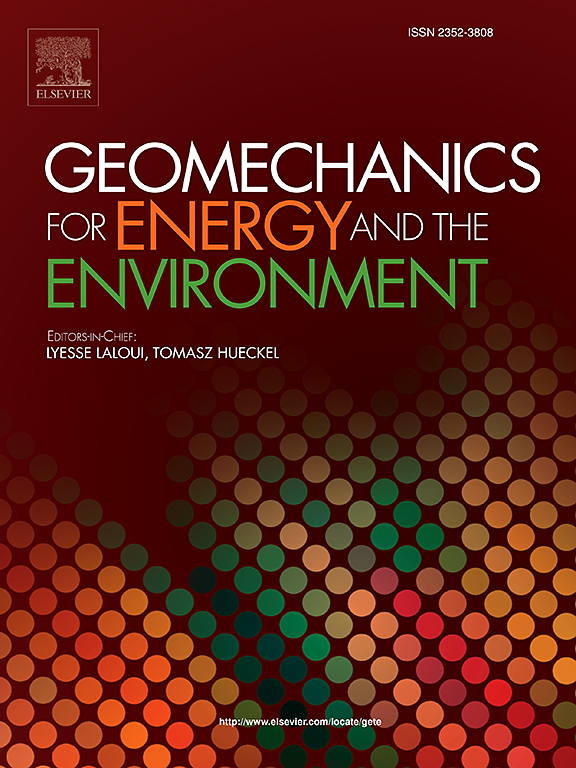Effects of chemical pollution from different pH solutions on evaporation and crack growth of granite residual soil
IF 3.7
2区 工程技术
Q3 ENERGY & FUELS
引用次数: 0
Abstract
In recent years, soil chemical pollution has emerged as a significant global environmental concern. Soil cracking induced by chemical pollution can alter the movement of water in the soil, consequently influencing the entire geological environment. Nevertheless, the consequences of diverse acid-alkali chemical pollutants on soil evaporation and cracking remain incompletely understood. In this investigation, the impact of varied pH chemical solutions on the evaporation and crack formation in granite residual soil (GRS) was examined. Mud samples were submerged in solutions of differing pH levels for 28 days while maintaining a constant temperature of 50°C. The findings demonstrate that as the pH of the solution increases, chemical pollution alters the inter-particle forces within soil, leading to an accelerated evaporation rate of GRS. At pH values of 3, 5, 7, 9, 11, and 13, the constant rate stage of soil water evaporation represented 78.9 %, 78.0 %, 76.1 %, 73.9 %, 69.6 %, and 69.0 % of the total evaporation time, respectively. Acid-alkali pollution significantly accelerates the development of cracks in GRS. For instance, at pH values of 3, 5, 9, 11, and 13, the final crack rate in soil samples increased by 56.56 %, 38.44 %, 19.06 %, 112.81 %, and 305.31 %, respectively, when compared to pH 7. The final fractal dimension of cracks increased by 2.29 %, 0.84 %, 0.63 %, 7.22 %, and 9.52 %, correspondingly. Varied pH levels in chemical solutions influence evaporation characteristics and crack development by altering the contact angle, the electric double layer (EDL), mineral composition, and the soil's microstructure. The research has uncovered an inverse relationship between the thickness of the EDL and contact angle or time of initial crack formation. Building upon this finding, a novel method is introduced to assess changes in EDL thickness. The findings of this study have practical implications for a range of applications related to hydrology and soil stability in the presence of acid-alkali pollution.
不同pH溶液化学污染对花岗岩残积土蒸发和裂缝生长的影响
近年来,土壤化学污染已成为全球关注的重要环境问题。化学污染引起的土壤龟裂会改变土壤中水的流动,进而影响整个地质环境。然而,人们对各种酸碱化学污染物对土壤蒸发和开裂的影响仍不甚了解。本研究考察了不同 pH 值的化学溶液对花岗岩残积土(GRS)蒸发和裂缝形成的影响。在保持 50°C 恒温的情况下,将泥土样本浸没在不同 pH 值的溶液中长达 28 天。研究结果表明,随着溶液 pH 值的升高,化学污染会改变土壤中颗粒间的作用力,从而导致花岗岩残余土壤蒸发速度加快。在 pH 值为 3、5、7、9、11 和 13 时,土壤水蒸发的恒定速率阶段分别占总蒸发时间的 78.9%、78.0%、76.1%、73.9%、69.6% 和 69.0%。酸碱污染大大加快了 GRS 裂纹的发展。例如,当 pH 值为 3、5、9、11 和 13 时,与 pH 值为 7 时相比,土壤样本的最终裂缝率分别增加了 56.56 %、38.44 %、19.06 %、112.81 % 和 305.31 %,裂缝的最终分形维数也相应增加了 2.29 %、0.84 %、0.63 %、7.22 % 和 9.52 %。化学溶液中不同的 pH 值通过改变接触角、电双层(EDL)、矿物成分和土壤的微观结构来影响蒸发特性和裂缝发展。研究发现,EDL 厚度与接触角或初始裂纹形成时间之间存在反比关系。在这一发现的基础上,引入了一种新方法来评估 EDL 厚度的变化。这项研究的结果对一系列与酸碱污染情况下的水文和土壤稳定性有关的应用具有实际意义。
本文章由计算机程序翻译,如有差异,请以英文原文为准。
求助全文
约1分钟内获得全文
求助全文
来源期刊

Geomechanics for Energy and the Environment
Earth and Planetary Sciences-Geotechnical Engineering and Engineering Geology
CiteScore
5.90
自引率
11.80%
发文量
87
期刊介绍:
The aim of the Journal is to publish research results of the highest quality and of lasting importance on the subject of geomechanics, with the focus on applications to geological energy production and storage, and the interaction of soils and rocks with the natural and engineered environment. Special attention is given to concepts and developments of new energy geotechnologies that comprise intrinsic mechanisms protecting the environment against a potential engineering induced damage, hence warranting sustainable usage of energy resources.
The scope of the journal is broad, including fundamental concepts in geomechanics and mechanics of porous media, the experiments and analysis of novel phenomena and applications. Of special interest are issues resulting from coupling of particular physics, chemistry and biology of external forcings, as well as of pore fluid/gas and minerals to the solid mechanics of the medium skeleton and pore fluid mechanics. The multi-scale and inter-scale interactions between the phenomena and the behavior representations are also of particular interest. Contributions to general theoretical approach to these issues, but of potential reference to geomechanics in its context of energy and the environment are also most welcome.
 求助内容:
求助内容: 应助结果提醒方式:
应助结果提醒方式:


